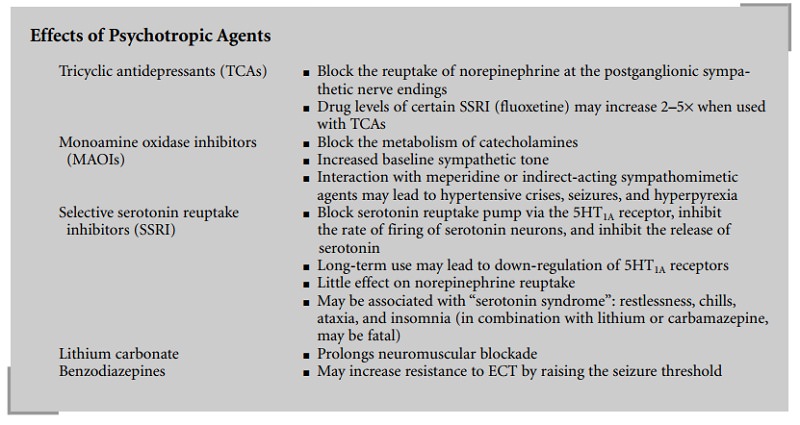Chapter: Clinical Cases in Anesthesia : Electroconvulsive Therapy
What are the anesthetic implications of psychotropic agents used in patients receiving ECT?
What are
the anesthetic implications of psychotropic agents used in patients receiving
ECT?
Patients undergoing ECT are usually taking
multiple psychotropic medications. These medications may include tricyclic
antidepressants (TCAs), lithium carbonate, monoamine oxidase inhibitors
(MAOIs), selective serotonin reuptake inhibitors (SSRIs), antipsychotics,
benzodiazepines, or miscellaneous second-generation antidepressants such as
bupropion.

TCAs (amitriptyline, amoxapine, clomipramine,
desipramine, doxepin, imipramine, nortriptyline, pro-triptyline, trimipramine)
block the reuptake of nore-pinephrine at the postganglionic sympathetic nerve
endings. As a result, the patient’s baseline sympathetic tone is increased.
Direct-acting sympathetic agents are therefore preferred to indirect-acting
agents that will increase the release of norepinephrine.
Several categories of drugs must be used with
caution with TCAs. These include: opioids (such as meperidine),
antihypertensives, potent volatile agents, and anticholiner-gics. TCAs bind to
albumin and therefore increase plasma levels of medications that bind to
albumin, such as thiopental, diazepam, phenytoin, and propranolol.
MAOIs (phenelzine, tranylcypromine) block the
meta-bolism of catecholamines, increasing baseline sympathetic tone as well.
The interaction between MAOIs and meperi-dine or indirect-acting
sympathomimetic agents has been shown to lead to hypertensive crises, seizures,
and hyper-pyrexia.
SSRIs (citalopram, fluoxetine, fluvoxamine,
paroxetine, and sertraline) may be associated with “serotonin syn-drome”, which
is characterized by restlessness, chills, ataxia, and insomnia. Fatal serotonin
syndrome may develop when an SSRI is combined with lithium or carbamazepine.
Certain SSRIs are inhibitors of the hepatic cytochrome P-450 system and may
increase drug levels of TCAs and β-blockers to toxic levels. Extreme caution must
be taken when prescribing SSRIs (particularly fluoxetine) to patients on these
medications.
Lithium carbonate may prolong the neuromuscular
blockade achieved by muscle relaxants. Patients taking long-acting
benzodiazepines may be resistant to ECT. These patients may require higher
energy levels in order to overcome their seizure threshold.
Related Topics